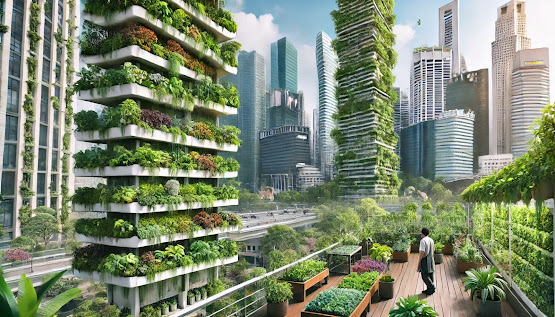Urban Farming
Urban farming refers to growing food in cities, using spaces such as rooftops, vacant lots, and even small backyards. It is emerging as a solution to provide locally grown, fresh produce in areas where traditional agricultural land is scarce. Some key aspects of urban farming include:
Community Impact:
Urban farms often serve local communities, reducing the distance food travels, which cuts down on transportation emissions and ensures fresher produce. They can also address food deserts—urban areas with limited access to fresh, healthy foods—by offering organic and affordable options to local populations
Sustainability:
Urban farming utilizes organic and eco-friendly practices, minimizing synthetic fertilizers and pesticides, and contributing to urban greening efforts, which improve air quality and reduce urban heat islands
Agroforestry and Trees:
In addition to food crops, urban farming can include planting trees, which provide ecological benefits such as carbon sequestration, temperature regulation, and shade. This contributes to the fight against climate change and improves urban living conditions
Vertical Gardens
Vertical gardening is a technique used to maximize space by growing plants upward rather than outward. This method is ideal for urban areas where ground space is limited. It is often employed in both outdoor urban farms and indoor farming operations, with some key benefits and techniques:
Space Efficiency:
Vertical gardens allow growers to produce more crops in a small area by stacking plants in layers or utilizing vertical structures like trellises, walls, or towers. This increases the potential yield per square foot, making it a popular method in urban settings
Technology Integration:
Many vertical gardens incorporate smart technologies such as automated watering systems, light controls, and nutrient monitoring, making it easier to maintain plants in dense or indoor environments. These systems can be controlled via mobile apps, offering precision farming in tight urban spaces.
Sustainability:
Vertical gardens often use hydroponics (growing plants without soil) or aeroponics (growing plants in an air or mist environment). These methods require less water and reduce the need for pesticides, making vertical farming more resource-efficient than traditional agriculture
Urban Design and Aesthetics:
Vertical gardens are also used to beautify urban environments by integrating greenery into building facades, improving air quality, and offering mental health benefits through increased exposure to nature
Together, urban farming and vertical gardens represent a significant shift towards more sustainable, space-efficient, and environmentally friendly agricultural practices in cities. They contribute to local food security, reduce the carbon footprint of food production, and bring nature back into densely populated areas.

.png)

.png)
